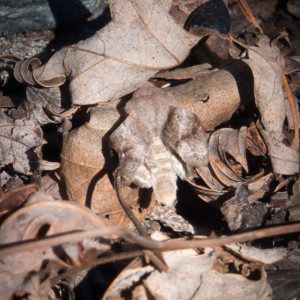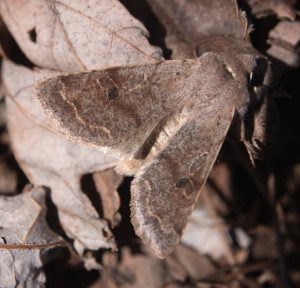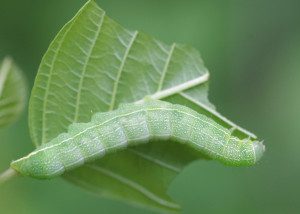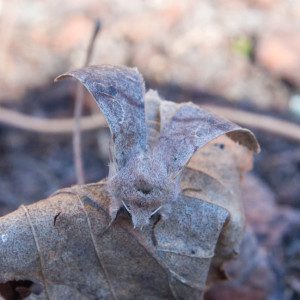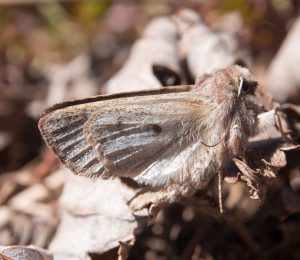Salutations, BugFans,
Guest location: the Twin Cities
Guest moth photographer: BugFan-in-Law Steve
At the very beginning of April, the BugLady received an email with pictures from her sister, BugFan Molly (who also mails interesting little packages containing six-legged critters). Seems that Molly spied something moving when she was out in her yard, looked closer, and then snagged her camera-wielding husband to record it. In her own words, “about 11:00 this a.m. I found this moth. It was crawling through the leaf litter in the garden. You could see only tiny buds of wings, barely visible on its back. In the time it took me to run into the house to get Steve & camera, the wings had exploded out…and kept on going… o my!”
If you’re having trouble finding it in the first shots, that’s the point of emerging as a leaf-colored moth on a leaf-covered substrate – good spotting, Molly!
It’s a Green-spotted fruitworm moth a.k.a Speckled green fruitworm moth and Speckled Green Quaker (Orthosia hibisci), a totally non-green moth that was obviously named after its caterpillar (unless it’s a Subdued Quaker Moth, Orthosia revicta, but the BugLady doesn’t think so).
Brief Aside – in recent years, the BugLady has not used abbreviations for insect names as frequently as she did in the early years, because she started checking what other meanings her abbreviations might have, lest she offend. She likes using the abbreviations, because some insect names are long and are repeated multiple times during an episode, and the BugLady, let’s face it, is a three-fingered typist. Corporate, military, geo-political, and academic acronyms are usually harmless, but, oh my, those people at the Urban Dictionary need to wash their brains out with soap! Ick!! Anyway, this one gets the Good Housekeeping Seal of Approval.
The SGFM/GSFM/SGQ is in the Owlet moth family Noctuidae, and in the subfamily Noctuinae, some of whose caterpillars, often called cutworms and armyworms, target agricultural crops. Noctuidae is a big family with more than 2,500 species in North America and about 12,000 worldwide, one of those “pardon our dust” groups whose taxonomy is constantly under review. The SGFM (not Surface Green Function Matching) is found from coast to coast in North America, but, since it likes woods and water, is found more sparsely in the desert and Great Plains.
There are a bunch of shots of unidentified caterpillars in the BugLady’s “X-files,” and by chance, a few of them look like they might be the GSFM (not Synthesis Gas From Manure). Caterpillar colors vary http://mothphotographersgroup.msstate.edu/species.php?hodges=10495. The caterpillars are catholic eaters – you can’t be picky if you burst upon the scene this early in the year. Their menu includes trees and shrubs in the rose, willow, maple, birch, honeysuckle, ash, heath (blueberry), and buckthorn families. The caterpillar pictured here was feeding on glossy buckthorn – BugFan Jim says that eventually, insects will discover that this aggressive, invasive shrub is a vast, unused food resource and will help to keep it in check.
The caterpillars, common in woodlands early in the season, make a welcome bit of protein for returning songbirds. Caterpillars start feeding on the leaves, then move to the flowers, and then to the fruits. The GSFM (not the Government Statistics Finance Manual) is on USDA Wanted Posters, because its nibbling on young fruit causes aborted fruits or deep, scarring/malformations https://entomology.ca.uky.edu/ef214, https://content.ces.ncsu.edu/green-fruitworm, and because when they are present in large numbers, they cause some defoliation (though they’re such early feeders that trees have time to put out new leaves). Their numbers vary from year to year and location to location; in big years, they’ll eat anything, and when populations are low they’re not considered much of a pest.
Adults, in the early days of spring, visit birch and maple sap drips for nourishment, and then switch to nectar from maple and willow flowers. They are considered pollinators.
SGQs (not the Scottish Guitar Quartet) overwinter as pupae in minimalist cocoons in the soil http://bugguide.net/node/view/894463/bgimage , ready to go when the ground warms. Females lay eggs (100 to 300 of them) in trees as the leaves emerge; their caterpillars are on the job by the end of April and have disappeared by the end of June, tucked away under the soil until the following year. There’s only one generation per year.
Although Molly’s moth emerged in the daylight, they are nocturnal. The BugLady needs to start turning her porch light on.
Kate Redmond, The BugLady
Bug of the Week archives:
http://uwm.edu/field-station/

